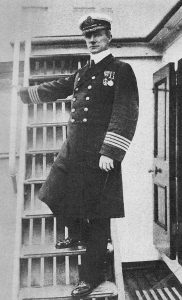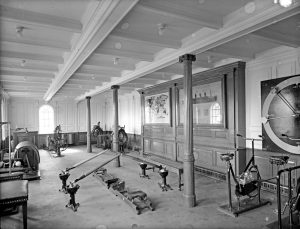
Public Domain via Wikimedia Commons
Titanic Museum displays pocket watch presented to Heroic Captain. (2024, August 15). WatchPro. https://www.watchpro.com/titanic-museum-displays-pocket-watch-presented-to-heroic-captain/
A pocket watch with a very heroic backstory has gone on display at Titanic Belfast. The timepiece is a Tiffany & Co. pocket watch that was presented to a ship’s captain for saving hundreds of passengers from the doomed Titanic. The 18th century 18k gold Rostron Pocket Watch was presented to Captain Rostron by the widows of three wealthy businessmen who were lost on the Titanic.
=

Photo: Robert Welch (1859–1936)
Public Domain via Wikimedia Commons
Kennedy, S. (2024, August 14). Thousands of Titanic artifacts are stored in a ‘secret’ warehouse somewhere in Atlanta, Georgia. MotorBiscuit. https://www.motorbiscuit.com/titanic-artifacts-secret-warehouse/
The storage facility is home to thousands of recovered Titanic artifacts. Its inventory includes everything from ship parts to personal possessions. Due to the value of these items, the location of the warehouse is kept private. We do know it’s somewhere in Atlanta, Georgia, though. The company operates under strict regulations regarding the recovery, storage, and display of artifacts in its exhibits worldwide. For example, the items can’t be sold separately and are considered a single, unified collection. Some of these artifacts are photographed and explained on the company’s site, like a bracelet with the jewel-studded name “Amy.”
=
Wade, A. (2024, August 14). Titanic’s Only Black Passenger and a Tragic Twist of Fate. Mail Online. https://www.dailymail.co.uk/femail/article-13738611/Titanic-black-passenger-Joseph-Laorche.html
Channel 4’s, Titanic in Colour, has shed light on some of the lesser-known personal stories, including that of a mixed race family who were on their way to build a new life and escape racial prejudice – only to be cruelly torn apart by the tragedy. In the first episode, which features newly colourised photos of the ship and its passengers, historians detailed the heartbreaking fate of Joseph Philippe Lemercier Laroche, believed to have been the only black man on board the Titanic. He was on his way home to his native Haiti from France with his pregnant wife and two daughters, after swapping their tickets from another vessel, which had a policy of separating children from their parents on board.
=

Image: Harper Collins (®) via Wikimedia Commons
Hewson, S. (2024, August 7). French explorer’s family sues for $50 million over implosion death. Fortune. https://fortune.com/2024/08/07/titanic-implosion-french-explorer-death-terror/
The family of a French explorer who died in a submersible implosion has filed a more than $50 million lawsuit, saying the crew experienced “terror and mental anguish” before the disaster and accusing the sub’s operator of gross negligence The lawsuit blames the implosion on the “persistent carelessness, recklessness and negligence” of Oceangate, Rush and others.“Decedent Nargeolet may have died doing what he loved to do, but his death — and the deaths of the other Titan crew members — was wrongful,” the lawsuit states.
Suggested Reading
Behe, G. (2012). On board RMS Titanic: Memories of the Maiden Voyage. The History Press.
Brewster, H. (2013). Gilded Lives, Fatal Voyage: The Titanic’s First-Class Passengers and Their World. National Geographic Books.
Eaton John P. & Haas Charles, TITANIC TRIUMPH AND TRAGEDY, SECOND EDITION, W.W. Norton & Company, New York, New York, 1995 First American Edition
Lord, Walter, A NIGHT TO REMEMBER, Holt Rinehart and Winston, New York, New York, 1955. Multiple revisions and reprints, notably Illustrated editions (1976,1977,1978 etc.)
Lord, Walter, THE NIGHT LIVES ON, Willian Morrow and Company, New York, New York, 1986 (First Edition)
Titanic News Channel is a participant in the Amazon Services LLC Associates Program, an affiliate advertising program designed to provide a means for sites to earn advertising fees by advertising and linking to Amazon.com.


















